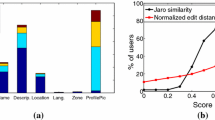Abstract
This paper addresses the important goal of quantifying the threat of linking external records to public Online Social Networks (OSN) user profiles, by providing a method to estimate the uniqueness of such profiles and by studying the amount of information carried by public profile attributes. Our first contribution is to leverage the Ads audience estimation platform of a major OSN to compute the information surprisal (IS) based uniqueness of public profiles, independently from the used profiles dataset. Then, we measure the quantity of information carried by the revealed attributes and evaluate the impact of the public release of selected combinations of these attributes on the potential to identify user profiles. Our measurement results, based on an unbiased sample of more than 400 thousand Facebook public profiles, show that, when disclosed in such profiles, current city has the highest individual attribute potential for unique identification and the combination of gender, current city and age can identify close to 55% of users to within a group of 20 and uniquely identify around 18% of users. We envisage the use of our methodology to assist both OSNs in designing better anonymization strategies when releasing user records and users to evaluate the potential for external parties to uniquely identify their public profiles and hence make it easier to link them with other data sources.
Access this chapter
Tax calculation will be finalised at checkout
Purchases are for personal use only
Preview
Unable to display preview. Download preview PDF.
Similar content being viewed by others
References
How microsoft and yahoo are selling politicians access to you, http://goo.gl/90d6j
Acquisti, A., Gross, R.: Predicting Social Security Numbers from Public Data. Proceedings of the National Academy of Sciences 106 (July 2009)
Blum, A., Dwork, C., McSherry, F., Nissim, K.: Practical Privacy: the SuLQ Framework. In: PODS (2005)
Calandrino, J., Kilzer, A., Narayanan, A., Felten, E., Shmatikov, V.: You might also like: Privacy risks of collaborative filtering. In: S&P (2011)
Chaabane, A., Acs, G., Kaafar, M.-A.: You Are What You Like! Information Leakage Through Users’ Interests. In: NDSS (2012)
Chen, T., Kaafar, M.A., Boreli, R.: Is More Always Merrier? A Deep Dive Into Online Social Footprints. In: SIGCOMM WOSN (2012)
Dwork, C.: Differential Privacy: a Survey of Results. In: Agrawal, M., Du, D.-Z., Duan, Z., Li, A. (eds.) TAMC 2008. LNCS, vol. 4978, pp. 1–19. Springer, Heidelberg (2008)
Eckersley, P.: How Unique is Your Web Browser? In: Atallah, M.J., Hopper, N.J. (eds.) PETS 2010. LNCS, vol. 6205, pp. 1–18. Springer, Heidelberg (2010)
Gale, W.A., Sampson, G.: Good-turning Frequency Estimation without Tears. Journal of Quantitative Linguistics (1995)
Gjoka, M., Kurant, M., Butts, C.T., Markopoulou, A.: Walking in facebook: A case study of unbiased sampling of osns. In: INFOCOM (2010)
Golle, P.: Revisiting the Uniqueness of Simple Demographics in the US Population. In: WPES (2006)
Irani, D., Webb, S., Li, K., Pu, C.: Large Online Social Footprints–An Emerging Threat. In: SIAM CS&E (2009)
Korolova, A.: Privacy Violations Using Microtargeted Ads: A Case Study. In: CDMW (2010)
Krishnamurthy, B., Wills, C.: On the Leakage of Personally Identifiable Information via Online Social Networks. In: ACM SIGCOMM CCR (2010)
Krishnamurthy, B., Wills, C.E.: Privacy Leakage in Mobile Online Social Networks. In: SIGCOMM WOSN (2010)
Lindamood, J., Heatherly, R., Kantarcioglu, M., Thuraisingham, B.: Inferring private information using social network data. In: WWW (2009)
McSherry, F., Mironov, I.: Differentially Private Recommender Systems: Building Privacy into the Netflix Prize Contenders. In: KDD (2009)
Mislove, A., Viswanath, B., Gummadi, K.P., Druschel, P.: You are Who You Know: Inferring User Profiles in Online Social Networks. In: WSDM (2010)
Narayanan, A., Shmatikov, V.: Robust De-anonymization of Large Sparse Datasets. In: S&P (2008)
Narayanan, A., Shmatikov, V.: De-anonymizing social networks. In: S&P (2009)
Perito, D., Castelluccia, C., Kaafar, M.A., Manils, P.: How Unique and Traceable Are Usernames? In: Fischer-Hübner, S., Hopper, N. (eds.) PETS 2011. LNCS, vol. 6794, pp. 1–17. Springer, Heidelberg (2011)
Dey, R., Jelveh, Z., Ross, K.W.: Facebook Users Have Become Much More Private: A Large-Scale Study. In: WSSN (2012)
Sweeney, L.: Uniqueness of Simple Demographics in the U.S. Population. LIDAP-WP4 Carnegie Mellon University (2000)
Sweeney, L.: k-anonymity: a Model for Protecting Privacy. Int. J. Uncertain. Fuzziness Knowl.-Based Syst. (October 2002)
Yen, T.-F., Xie, Y., Yu, F., Yu, R.P., Abadi, M.: Host Fingerprinting and Tracking on the Web: Privacy and Security Implications. In: NDSS (2012)
Zheleva, E., Getoor, L.: To Join or not to Join: the Illusion of Privacy in Social Networks with Mixed Public and Private user Profiles. In: WWW (2009)
Author information
Authors and Affiliations
Editor information
Editors and Affiliations
Rights and permissions
Copyright information
© 2013 Springer-Verlag Berlin Heidelberg
About this paper
Cite this paper
Chen, T., Chaabane, A., Tournoux, P.U., Kaafar, MA., Boreli, R. (2013). How Much Is Too Much? Leveraging Ads Audience Estimation to Evaluate Public Profile Uniqueness. In: De Cristofaro, E., Wright, M. (eds) Privacy Enhancing Technologies. PETS 2013. Lecture Notes in Computer Science, vol 7981. Springer, Berlin, Heidelberg. https://doi.org/10.1007/978-3-642-39077-7_12
Download citation
DOI: https://doi.org/10.1007/978-3-642-39077-7_12
Publisher Name: Springer, Berlin, Heidelberg
Print ISBN: 978-3-642-39076-0
Online ISBN: 978-3-642-39077-7
eBook Packages: Computer ScienceComputer Science (R0)




